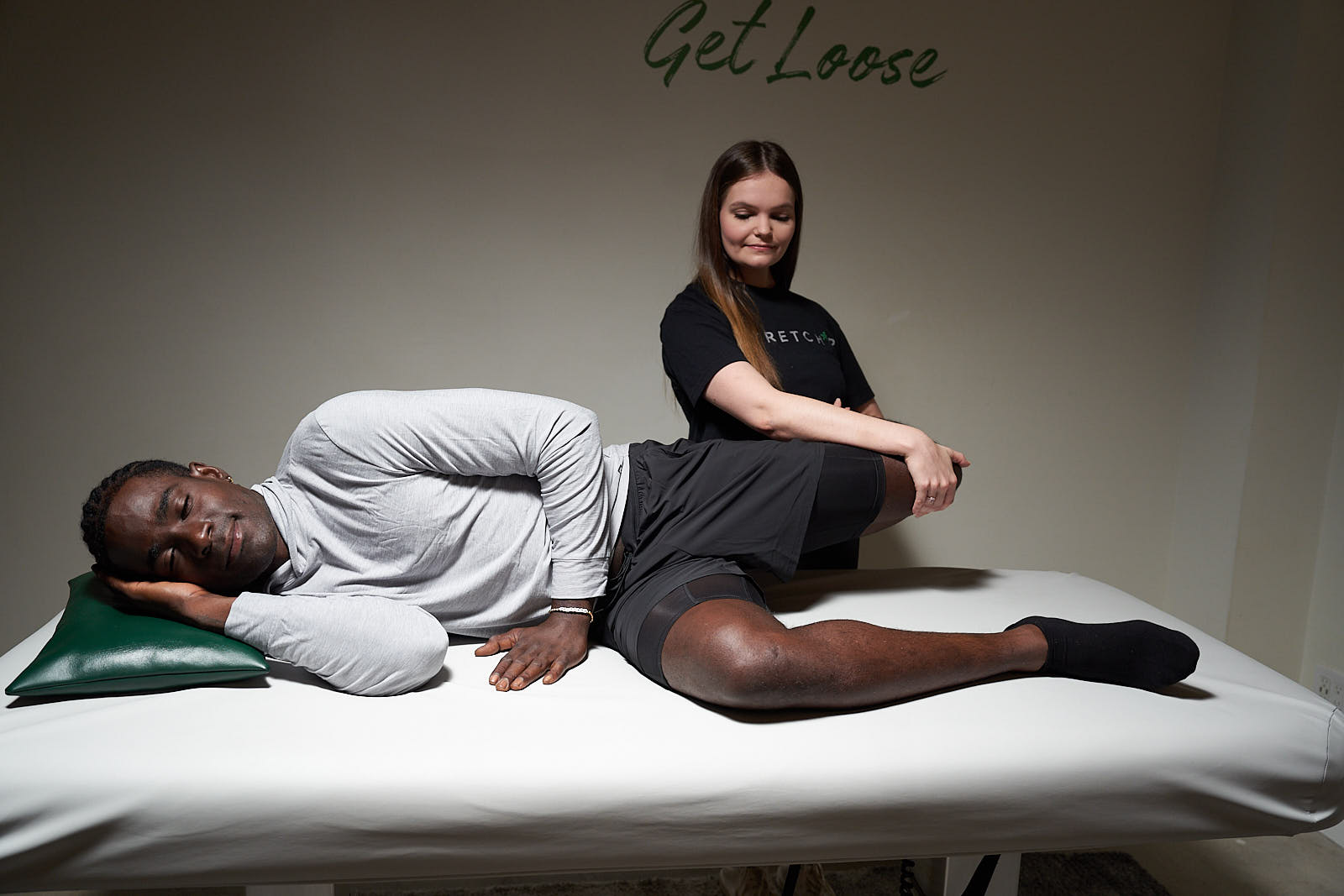Dynamic vs. Static Stretching: Key Differences Explained
You’ve probably heard that stretching is a vital part of not only exercise but also staying mobile, flexible, and agile. This goes for everyone—athletes, older adults, fitness beginners, new parents, folks who haven’t been active for a while, desk workers, you name it. But there are different types of stretching, two main ones being static and dynamic stretching.
The latter is usually best pre-workout, but why is dynamic better than static stretching for warm-ups? And what’s the difference between dynamic versus static stretching, exactly? Read on for answers to these questions, along with key benefits and examples of each.

What is the difference between static and dynamic stretching?
The primary difference between static and dynamic stretching is that dynamic stretching is most often used as a warm-up, and static stretching is typically done after physical activity or as a standalone activity.
- Dynamic stretching – Dynamic stretching involves moving your arms, legs, muscles, and joints, focusing on areas that’ll be worked out in the upcoming exercise session. You can also target all major muscle groups if you’ve got a whole-body workout ahead. The goal is to prepare the body for more intense activity.
- Static stretching – Static stretching, on the other hand, is when you hold a stretch or pose for at least 10 seconds, possibly up to 30 seconds or a minute. The goal is to enhance flexibility, lengthen muscles, and aid recovery after a workout.
Dynamic stretching benefits and uses
Dynamic stretches are movement-based. The motions increase blood flow and get your heart rate up to actively warm up the body. By gently engaging muscles and moving joints through a full range of motion, this approach can alleviate stiffness and prime your body for exercise and daily activity.
Another benefit of dynamic stretches is that they can help minimize the risk of injury during a workout. How so? Motion-based stretching boosts agility and flexibility while delivering blood flow and oxygen to muscles, getting them ready for the harder moves ahead.
What’s more, dynamic stretching might give you a leg up on exercise performance. For instance, these low-impact, repetitive movements may help you squat lower, jump higher, or cycle faster.
Dynamic stretching examples
There are tons of dynamic stretches you can incorporate into your warm-up routine. Here are several examples:
- Arm circles or swings
- Shoulder rolls
- Alternating front kicks or leg swings
- Calf raises
- Hip circles
- Torso twists
- Walk-outs (aka inchworms)
- Walking lunges
So long as you stay in motion, a few easier yoga poses can count as dynamic stretches, like a warrior flow or cat-cow stretch.
Static stretching benefits and uses
As mentioned, static stretching is often used as part of a cool-down following exercise. It can improve flexibility, lengthen muscles, ease tightness, and help the body relax. These stationary stretches might also help prevent or minimize muscle soreness in the day or two after a strenuous workout.
Static stretching examples
Here are a few common examples of static stretches:
- Standing one-legged quad stretch
- Bending over or sitting and reaching toward the toes
- Seated butterfly stretch
- Overhead tricep stretch with elbow bent
- Standing calf stretch
Certain yoga poses can be used in static stretching routines as well, including downward dog, child’s pose, and pigeon pose.
Why is static stretching not recommended for warm-ups?
Static stretching usually isn’t recommended for warm-ups because, while it can improve flexibility, it doesn’t warm up the body or prepare muscles for exercise—and could actually hinder performance in some cases.
Meanwhile, dynamic stretches increase circulation, sending blood flow and oxygen to muscles, and prepare the body for more intense moves to help with performance and prevent injury.
Dynamic stretching vs. ballistic stretching
Dynamic stretching is sometimes confused with ballistic stretching, which involves quick, repetitive, high-intensity movements—think jumping or bouncing. These high-impact moves are OK to include in interval workouts, but they aren’t right for a warm-up because the body needs to, well…warm up before performing such difficult moves.
Active, passive, and assisted stretching
There’s also active stretching, which is sort of like static stretching, only another body part is used as resistance when holding the position.
Passive stretching involves using an external force—like another person, a wall, or a piece of equipment—to help lengthen your muscles while you stay relaxed. It’s often slow and held for longer periods without active movement.
However, not all Assisted stretching is done in a passive manner. In fact, at Stretch*d, our method combines assistance with dynamic movement, meaning we guide your body through stretches that are active, flowing, and personalized to your needs. This approach helps increase mobility, boosts circulation, decreases risk of injury or overstretching and delivers longer-lasting results.
How long should you do dynamic or static stretches?
You can warm up with dynamic stretches for anywhere from two to ten minutes before more intense exercise. If you’re using static stretching as a cool-down, take about three to five minutes working through each move to stretch the muscles you just worked. Hold each move for 10 to 30 seconds until you become more flexible.
Our blog has more insight into how long you should stretch.
Stretching: a critical component of fitness and mobility
Dynamic stretching is essential to do before a workout, helping warm up the body and prep muscles for exercise. Even a quick dynamic warm-up can be well worth it, allowing you to perform the upcoming moves better and lower your injury risk.
You can also do dynamic stretches on their own whenever you have a few spare minutes to improve mobility, increase range of motion, get a blood flow boost, and move more comfortably throughout your day. Static stretching can also be really beneficial for muscle recovery and flexibility, though it’s best saved for after physical activity.
If you’re in the NYC area and need assistance with stretching (or just want to unwind while a pro handles the rest), consider assisted stretching or even stretch massage at a Stretch*d studio. Book a session at your nearest location.
Sources:
Cleveland Clinic. Dynamic vs. Static Stretching: Is One Better? https://health.clevelandclinic.org/dynamic-stretching-vs-static-stretching
Journal of Sports Science & Medicine. Dynamic Stretching Has Sustained Effects on Range of Motion and Passive Stiffness of the Hamstring Muscles. https://pmc.ncbi.nlm.nih.gov/articles/PMC6370952/
Arthroscopy, Sports Medicine, and Rehabilitation. Dynamic Warm-ups Play Pivotal Role in Athletic Performance and Injury Prevention. https://www.sciencedirect.com/science/article/pii/S2666061X24001664
BMC Musculoskeletal Disorders. The effect of warm-up, static stretching and dynamic stretching on hamstring flexibility in previously injured subjects. https://bmcmusculoskeletdisord.biomedcentral.com/articles/10.1186/1471-2474-10-37
Cleveland Clinic. Active Stretching: What It Is and How To Do It. https://health.clevelandclinic.org/active-stretching
University of Nebraska – Lincoln. Effects of Dynamic Stretching on Strength, Muscle
Imbalance, and Muscle Activation. https://digitalcommons.unl.edu/cgi/viewcontent.cgi?article=1105&context=nutritionfacpub
Applied Sciences. Does the Inclusion of Static or Dynamic Stretching in the Warm-Up Routine Improve Jump Height and ROM in Physically Active Individuals? A Systematic Review with Meta-Analysis. https://www.mdpi.com/2076-3417/14/9/3872
International Journal of Sports Physical Therapy (IJSTP). Current Concepts in Muscle Stretching for Exercise and Rehabilitation. https://pmc.ncbi.nlm.nih.gov/articles/PMC3273886/
International Journal of Exercise Science (IJES). The Effects of Static and Dynamic Stretching on Muscle Oxygen Saturation in the Rectus Femoris. https://pubmed.ncbi.nlm.nih.gov/35991352/
Journal of Athletic Training. Stretching Before and After Exercise: Effect on Muscle Soreness and Injury Risk. https://pmc.ncbi.nlm.nih.gov/articles/PMC1250267/
Cleveland Clinic. Active Stretching: What It Is and How To Do It. https://health.clevelandclinic.org/active-stretching

